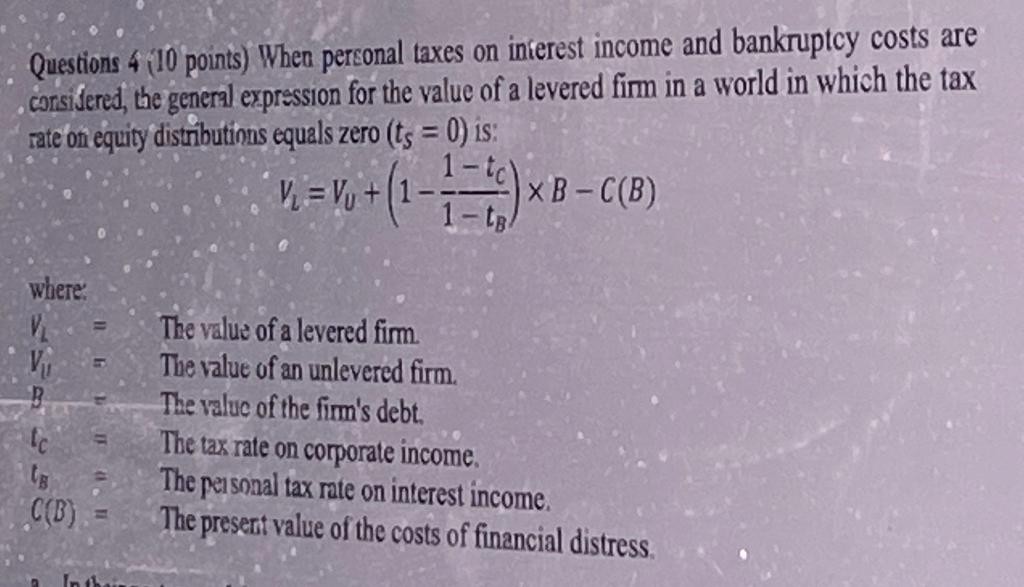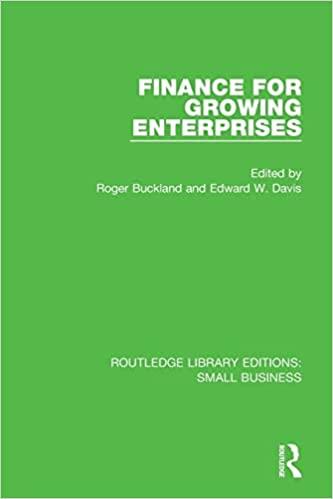

Questions 4 (10 points) When personal taxes on interest income and bankruptcy costs are considered, the general expression for the value of a levered firm in a world in which the tax rate on equity distributions equals zero (ts = 0) is: -tc = XB-C(B) V = vo +(1-1) -TB where: Vi Ic The value of a levered fimm The value of an unlevered firm. The value of the firm's debt. The tax rate on corporate income. The personal tax rate on interest income The present value of the costs of financial distress C(B) CIB) The personal tax rate on interest income. The present value of the costs of financial distress. a. In their no-tax model, what do Modigliani and Miller assume about to to, and C(B)? What do these assumptions imply about a firm's optimal debt-equity ratio? (2 points) b. In their model with corporate taxes, what do Modigliani and Miller assume about tc, tb, and C(B)? What do these assumptions imply about a firm's optimal debt-equity ratio? (2 points) c. Consider an all-equity firm that is certain to be able to use interest deductions to reduce its corporate tax bill. If the corporate tax rate is 34 percent, the personal tax rate on interest income is 20 percent, and there are no costs of financial distress, by how much will the value of the firm change if it issues $1 million in debt and uses the proceeds to repurchase equity? (3 points) d. Consider another all-equity firm that does not pay taxes due to large tax loss carryforwards from previous years. The personal tax rate on interest income is 20 percent, and there are no costs of financial distress. What would be the change in the value of this firm from adding Sl of perpetual debt rather than $1 of equity? (3 points) Questions 4 (10 points) When personal taxes on interest income and bankruptcy costs are considered, the general expression for the value of a levered firm in a world in which the tax rate on equity distributions equals zero (ts = 0) is: -tc = XB-C(B) V = vo +(1-1) -TB where: Vi Ic The value of a levered fimm The value of an unlevered firm. The value of the firm's debt. The tax rate on corporate income. The personal tax rate on interest income The present value of the costs of financial distress C(B) CIB) The personal tax rate on interest income. The present value of the costs of financial distress. a. In their no-tax model, what do Modigliani and Miller assume about to to, and C(B)? What do these assumptions imply about a firm's optimal debt-equity ratio? (2 points) b. In their model with corporate taxes, what do Modigliani and Miller assume about tc, tb, and C(B)? What do these assumptions imply about a firm's optimal debt-equity ratio? (2 points) c. Consider an all-equity firm that is certain to be able to use interest deductions to reduce its corporate tax bill. If the corporate tax rate is 34 percent, the personal tax rate on interest income is 20 percent, and there are no costs of financial distress, by how much will the value of the firm change if it issues $1 million in debt and uses the proceeds to repurchase equity? (3 points) d. Consider another all-equity firm that does not pay taxes due to large tax loss carryforwards from previous years. The personal tax rate on interest income is 20 percent, and there are no costs of financial distress. What would be the change in the value of this firm from adding Sl of perpetual debt rather than $1 of equity? (3 points)








